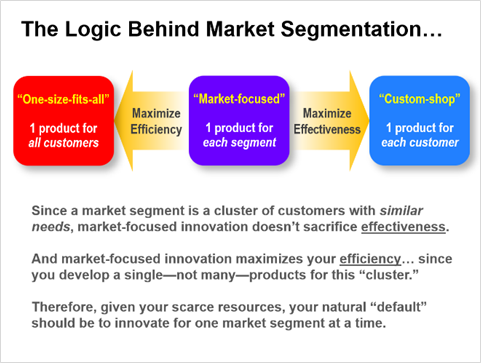1. Why is market segmentation critical?
Here's why it's best to focus your product development on a market segment.
There are many ways to “segment” in your business. To be clear, we’re talking here about segmentation for the purpose of delivering new products and services. (For instance, this isn’t about segmenting your existing customers by their behavior so you can serve them differently on a day-to-day basis.)
We define a market segment as a “cluster of customers with similar needs.” To see why this works, imagine two extremes:
- One-size-fits-all: Here you decide to have one product for all your customers. Operationally, this would be quite efficient, right? But it would be terribly ineffective, since you’d make very few customers happy.
- Custom-shop: In this case, you decide to make a unique product for every single customer. This would be very effective, since each customer gets exactly what they want… but incredibly inefficient for your operations.
OK, those were extreme. But here’s the point: If a market segment is a cluster of customers with similar needs, then market segmentation gives you the optimal balance of effectiveness and efficiency. Every product is effective in meeting customer needs, and you have efficiently produced only as many new products as needed. Since both you and your competitors are resource-constrained, you’ll eventually out-pace competitors if you pursue market-focused innovation and they don’t.

Caveat: There may be times when a single customer is large enough or important enough for you to develop a product just for them. But try to follow this rule: Always ask yourself first, “Could this—should this—be a market-facing project?”
For more on market segmentation, check out the 2-minute video, Segment by markets for innovation, part of the B2B Organic Growth video series by Dan Adams.
Keywords: Market segmentation, market segment, cluster of customers, effectiveness, efficiency, market focused
